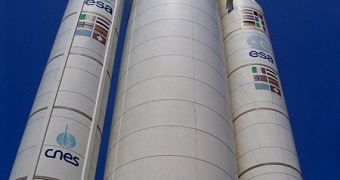According to the annual report recently released by the Arianespace delivery system consortium, the companies involved in the development of the Ariane 5 ECA rocket will begin to make minor modifications to the vehicle, which will allow it to increase its payload capacity by more than 400 kilograms by 2010. The tweaks are not major and do not imply reworking the entire design. Rather, they are focused on increasing the existing cargo capacity and on rearranging some components to make more room for commercial transports, such as satellites, for future launches.
The goal of these changes is to enable the European-built delivery system to carry two telecommunication satellites at the same time, with a combined weight of 9,100 kilograms. The payload will have to be lifted to a geostationary transfer orbit, and there are currently very few delivery systems that can compete for safely completing this mission. The revised Ariane will also change its engine-firing times, so as to allow some thrusters to burn longer than they have done until now.
On April 9th, Jean-Yves Le Gall, the chief executive at Arianespace, told reporters that the changes would not affect hardware components in the spacecraft, Space reports. He said that the changes had been prompted by the fact that existing payload configurations available for the Ariane did not make the most use of the available space, and that, at times, the company found it hard to match pairs of satellites to send in orbit. On these occasions, the space that remains between the two payloads could easily accommodate a third, so engineers are now looking at ways of making that a reality.
At the European Space Agency's (ESA) French Guiana Space Center, officials have already decided to construct a launch pad able to deliver the famous Soyuz missiles into space, after they agreed to invest 121 million euros ($163 million) into purchasing the rockets from their manufacturer. The deal has been approved by the EU and Russia, and engineers at the Guiana spaceport hope to make the inaugural flight possible by December.
In part, the fact that Arianespace has started investing in its Ariane 5 delivery system shows that the EU and ESA are still doubtful about how feasible launching satellites from South America aboard Russian-built Soyuz missiles is. Officials are most likely looking for a comparison between the two costs, once the new version of Ariane 5 is complete.

 14 DAY TRIAL //
14 DAY TRIAL //